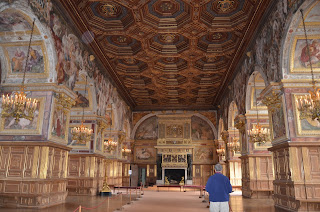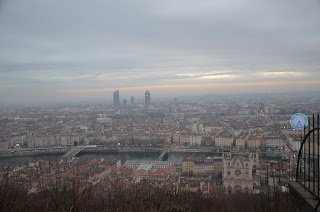We began our first full day of Parisian
adventures with the Rodin Museum. I was surprised to learn that Rodin wasn’t
famous until his 40s and that his fame was due to one piece that never actually
got installed. Basically, Rodin was
commissioned to do an entryway for the Museum-to-be of Decorative Arts and (I believe)
was given the theme “gates of hell”. He originally drew inspiration from Dante’s
The Inferno, portraying scenes
inspired by the various levels of hell and historic figures described in the text.
He showed his working draft to some art critics and friends, who went WILD over
it, and overnight Rodin became famous.
Of course, the Gates of Hell piece was still unfinished, and he
continued to rework it, making the themes less and less representative of Dante’s
text and more personal. The exhibit claims Rodin’s work took another turn when
he became inspired by The Flowers of Evil
by Baudelaire. So he worked and reworked and reworked on The Gates of Hell. But then the bottom fell out of the project –
the Museum of Decorative Arts development was discontinued, leaving the gates
with no future home. Instead, the gates sat in the back of Rodin’s studio for
the rest of his life, a backdrop and an inspiration for his future work. Indeed,
almost all of Rodin’s famous statues (The
Thinker, The Kiss, etc) are
actually enlarged elements of the Gates
of Hell design.
 |
| A cast of The Gates of Hell, created after Rodin's death from the draft of the gates in his studio. |
It’s pretty incredible, isn’t it? At 40, unknown. At 60,
famous and sought-after, with a school of students, purchasing an old hotel
(Hotel Biron) to become his personal museum. Rooms filled with artist friends’
work, including their portraits of Rodin. Beautiful gardens to showcase his
sculptures, their anatomic detail stunning.
I guess it’s an inspiration to those whose passions don’t pan out the
way they want them to… success could be just around the corner.
For a late lunch, we tried to return to the fondue place we
discovered on our last Paris trip, but we were foiled! It was not open.
Luckily, we found this tiny crepe and sandwich shop, where we were the only
(very confused) patrons unable to speak French. But the paninis were hot and
the crepes were delicious. We stood on
the pavement surrounded by our crepe-consuming comrades and devoured our
Parisian fast food.
(The shop didn’t seem to have a unique name, but if you want
to find it, it’s on Rue de la Harpe where it starts at the Seine.)
We had planned to have an adventurous afternoon, but we were
fairly worn out and instead spent the afternoon wandering along the Seine and
exploring the shops by our apartment. We needed to work up an appetite for the
most anticipated part of the trip…
At 7:30 sharp, we arrived outside Pavillon Ledoyen, a
three-Michellin Star restaurant in the Ledoyen Champs Elysees gardens. As we
entered the main dining room, we noticed that the area was fairly hushed and
that all of the chairs (when they didn’t surround the whole table) were angled
for optimal viewing of the city lights through the window. A gold half-circle
held a candle; suited waiters held out our chairs. Since we had tried a la
carte dishes at Paul Bocuse, we decided to up the ante and ordered the seven
course prix fixe menu this time. Of course, “seven courses” doesn’t really mean
seven courses. That number doesn’t include the appetizer given to all the
restaurant patrons, the optional cheese course, the tea/coffee course at the
end of the meal (which came – SURPRISE! – with three additional desserts).
Our courses: (note: I don’t have the menu in front of
me so I will not do it justice)
·
(Appetizer) We had a miso jelly soup and
seaweed-flavored crème in a pastry shell, served on top of a smoked eel
(including the head. Yes, the whole eel
was curled up on the plate, and no, we didn’t think we were supposed to eat
it).
·
(Course 1) Delicious layers of avocado and
celeriac with lemon and coconut extract, one of my favorite courses of the
night.
·
(Course 2) Next came foix gras (which we barely
touched, to the dismay of our waiter… I had seen the word “duck” and gotten
excited, failing to read which part of the duck they were serving) accompanied
by a smoked eel puree, topped with spaghetti squash and yeast flakes.
·
(Course 3) Scallops gently sliced in a delicious
sauce that I don’t even know how to describe, but oh so melt-in-your-mouth
wonderful.
·
(Course 4) Lobster on a bed of roasted pepper
with ribs of kale and a turnip gel. Oh lobster, you are delicious steamed with
butter but you are mighty fine when gussied up.
·
(Course 5) Wagyu beef with squid ink and star
anise, topped with eggplant roasted into submission and tiny black orecchiette
filled with something fascinating and tart.
·
(Optional – but really necessary – cheese course)
How could we say no to cheese? We had passed over it at Paul Bocuse, but we had
agreed to go all out tonight. We sampled 36-month-old Comte (amazing! Delicious!
Undertones of caramelization like a good aged Gouda), an incredible goat cheese
(selles sur cher, from Loire), and two other types. We were pleased with our
selections (and the help of the Ledoyen Cheese Guru), but our clothes felt
tighter than ever.
·
(Course 6) Apple pie without the dough; instead,
it was a crunch bottom topped with a sort of apple sauce topped with roasted
apple, with little crunch bits arranged around the edge like numbers on a
clock. Tart Granny smith sorbet perched on top of this small apple tower. It
was beautiful until the first bite, which required smooshing the entire thing,
but it was delicious.
·
(Surprise course!) These strange half-circles,
with tops spiked like hedgehogs, had been placed on our table at the beginning
as a “surprise secret”, with no further details offered. They were now sliced
open by our waiter, who explained that they were roasted passionfruit. After
being roasted, they had been injected with cream, which was curdled by the
natural acidity of the fruit to make a sort of creamcheese. The waiter then generously
sprinkled brown sugar on top and brulee-ed it, for a fascinating twist on that
singularly French dish, crème brulee. It was light and tart - far more tart
than the normal cream in a crème brulee, which my taste buds enjoyed. My inner
chemistry nerd was definitely impressed.
·
(Course 7) A light chocolate mousse that
probably had some fancy twist that I am unable to remember.
·
(Birthday surprise!) Our waiters then placed
more silverware down, a sign of more food to come. Our stomachs doth protest,
we said, but still they brought a cake. It was a pear cake with crumbly cookie
bottom layers, melty middle layers, and little meringues on top. Josh and I
begged for small slices, but our waiter (that cruel, cruel man) served us
generous portions that we could not resist.
·
(My own fault) The waiter then asked if we
wanted tea or coffee. I asked for chamomile tea, thinking it would buy us time
to relax before our walk home. And then the forks and knives were laid down,
and I knew I was in for more food. Tea, as I previously mentioned, came with
its own trio of desserts, ranging from tiny tidbits (little mint jellies with
wisps of chocolate) to plate-sized monstrosities (Guinness cake that didn’t
taste like Guinness and instead tasted like crème brulee pie). We barely made a
dent.
Did we roll out of Ledoyen? Possibly. It was
hard to remember anything clearly between my mad sugar rush and the resulting
slump. But I do know that the lights were sparkling over the city and that the
Louvre Gardens bordering our path home were beautiful. It was nearly 1 am on a
Tuesday in Paris, but time didn’t seem to matter anymore.
Spotted: French museum bathrooms sometimes have a shoe shining machine. The Spanish tourists sitting near me were incredibly excited about this.



























